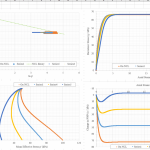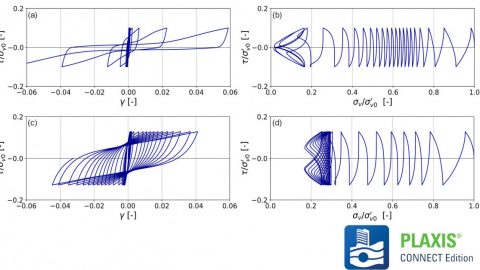Hi Prof. David,
I have obtained these results in that attached picture using Triax and got confused when seeing that an isotopically normally consolidated sample does not follow a trend that looks similar to the traditional Roscoe Surface. Have I done something wrong or this is what is expected from your hypoplastic model?
Thank you,
Hashmi
Undrained Tests with Basic Clay Hypoplasticity
Related Articles
-
Hypoplastic model for Granular soil
 Naveen Meena||Constitutive Modelling|5 |Views 4,963
Naveen Meena||Constitutive Modelling|5 |Views 4,963
Hello everyone, Could you please anyone tell me that how I can define the hypoplastic constitutive model for granular soil in ABAQUS 6.13. With Regards, Naveen. -
VUMAT ABAQUS: sandy soil
 hoang thai an||Constitutive Modelling|2 |Views 4,616
hoang thai an||Constitutive Modelling|2 |Views 4,616
Dear PhD, I am studying roller vibrations on sandy soil models with vumat. Can PhD give me the subroutine model and input parameters of objects for reference? Unit of the […] -
-
CEL analysis using hypo plasticity Vumat
 abd Elfattah||Constitutive Modelling|8 |Views 4,827
abd Elfattah||Constitutive Modelling|8 |Views 4,827
Greetings i used interface Vumat with Umat for simulating CEL problem, after 50% of analysis, i got the error as “Excessive incremental rotation of the elements in element set ” […] -
Hypoplastic UMAT & Void Ratio
 Hashmi Sohawon||Constitutive Modelling|0 |Views 5,622
Hashmi Sohawon||Constitutive Modelling|0 |Views 5,622
Hi all, Can anyone give a clarification on the material property (parameter 22) in the hypopplasticity umat for clay on Abaqus. My understanding is that these parameters are defined as […] -
Sand Hypoplasticity calibration
 Francisco Mendez||Constitutive Modelling|1 |Views 3,982
Francisco Mendez||Constitutive Modelling|1 |Views 3,982
Good evening, everyone. I find it difficult to apply equations (13) and (14) of Herle’s publication “Determination of parameters of a hypoplastic constitutive model from properties of grain assemblies”. As […] -
UDSM PLAXIS
 nasim aftahi||Constitutive Modelling|2 |Views 4,642
nasim aftahi||Constitutive Modelling|2 |Views 4,642
I implemented a unified dynamic soil model, but PLAXIS doesn’t calculate any strains, and it prints zero (or some times NaN amounts) into a text file. I’d like to know […] -
Hypoplasticity & Recent Stress History
 Hashmi Sohawon||Constitutive Modelling|2 |Views 4,227
Hashmi Sohawon||Constitutive Modelling|2 |Views 4,227
Hi David, Can you please provide some comments on the ability of the Hypoplasticity model with intergranular strain concept to model the effects of recent stress history on the clay […]
Search SoilModels Website
Recent posts
-
 Degradation ( disturbance ) of hypoplastic clay 23.4.2024
Degradation ( disturbance ) of hypoplastic clay 23.4.2024
-
 Degradation ( disturbance ) of hypoplastic clay 23.4.2024
Degradation ( disturbance ) of hypoplastic clay 23.4.2024
-
 Paper of Coulomb, C. A. (1773) 15.4.2024
Paper of Coulomb, C. A. (1773) 15.4.2024
-
 ABAQUS UMAT of hypoplastic clay model 6.4.2024
ABAQUS UMAT of hypoplastic clay model 6.4.2024
-
 Prague Geotechnical Days 2024 “Geotechnical monitoring” and 30th jubilee Prague Geotechnical Lecture by prof. Eduardo Alonso 5.4.2024
Prague Geotechnical Days 2024 “Geotechnical monitoring” and 30th jubilee Prague Geotechnical Lecture by prof. Eduardo Alonso 5.4.2024
-
 UMAT for Creep-SCLAY model. 1.3.2024
UMAT for Creep-SCLAY model. 1.3.2024
-
 Cyclic tests with Triax element test driver 14.2.2024
Cyclic tests with Triax element test driver 14.2.2024
-
 SUMMER SCHOOL ‘Numerical Modelling in Geotechnical Engineering’, Innsbruck – July 22nd-26th, 2024 1.2.2024
SUMMER SCHOOL ‘Numerical Modelling in Geotechnical Engineering’, Innsbruck – July 22nd-26th, 2024 1.2.2024
-
 COURSE IN SOIL MODELING – NTNU, Trondheim – October 14th to 18th, 2024 21.12.2023
COURSE IN SOIL MODELING – NTNU, Trondheim – October 14th to 18th, 2024 21.12.2023
-
 MSE walls design in Plaxis 11.12.2023
MSE walls design in Plaxis 11.12.2023
-
 sand liquefaction modelling in Anura3D 8.12.2023
sand liquefaction modelling in Anura3D 8.12.2023
-
 BCV bentonite experimental and modelling datasets 14.11.2023
BCV bentonite experimental and modelling datasets 14.11.2023
Recent Comments
- KHA DIDJA on Animating Soil Models
- Jh Xue on Undrained Tests with Clay Hypoplasticity Intergranular
- Zhentao Liu on Problem in simulating CPT using SANISAND04
- Gertraud Medicus on ABAQUS UMAT of hypoplastic clay model
- Chen Zhiming on Download Package of Charles University Implementation of High Cycle Accumulation Model
- Konstantinos Chatzis on Cyclic tests with Triax element test driver
- Abhay Pratap Singh on Cyclic tests with Triax element test driver
- Giovanni Ciardi on Cyclic tests with Triax element test driver
- Konstantinos Chatzis on Cyclic tests with Triax element test driver
- Ismail Khan on Cyclic tests with Triax element test driver
- Kanika Lamba on Cyclic tests with Triax element test driver
- Arie Koot on How to model the settlement in soil due to water drawdown.
- Konstantinos Chatzis on Cyclic tests with Triax element test driver
- Jose Duque on Cyclic tests with Triax element test driver
- MohamadReza Kamali on How to model the settlement in soil due to water drawdown.
- Leo Alibert on MSE walls design in Plaxis
- Ignacio Zuloaga on MSE walls design in Plaxis
- Giada Orlando on Problem with VUMAT interface





Dear Hashmi, this is correct response of the model. Actually, the observed shape of stress path is due to response envelopes being translated elipses in the stress space. The normally consolidated sample response can be corrected by either using intergranular strain concept, or by so-called D-dependent L approach. It is discussed thoroughly in this reference: Mašín, D. and Herle, I. (2007). Improvement of a hypoplastic model to predict clay behaviour under undrained conditions. Acta Geotechnica 2, No. 4, 261-268. Regards David
ok, thank you David.
Can you please provide a clarification on the following:
In triax program, the following are the inputs when using hypo_clay with istrain:
fi cr, lambda, kappa, N, r, R, mr, mt, betar, chi, e0
however, when referring to your notes, it says that for hypo_clay mR is replaced by Ag and ng while mT is supplemented by mrat instead. Therefore, how can i make triax recognise these input parameters: Ag, ng and mrat?
Correct, this is because hypo_clay is 2005 version of clay model. To use the most recent clay version, use hypo_clay_anisot and set anisotropy factor alpha_G = 1. Regards David
ok thank you. is there an updated pdf manual that includes the newer versions of hypo_clay models in triax that came after 2005?
I am currently using hypoplasti_clay_anisot_istrain, can you please confirm that the parameter nu is poisson’s ratio?
Hi David,
Can you please clarify the following parameters in Triax:
hypoplasti_clay_anisot_istrain: fi cr, lambda, kappa, N, nu, alpha, R, betar, chi, G0, n, mtrat, inic. his. var.: e0, istrain, pt
1. what is G0? confused that it could mean Ag or is it just initial shear stiffness?
2. is the n the same as ng?
3. what to insert for istrain and pt after e0? (i initially left them blank)
Thanks!
Hi Hashmi, G0=Ag, n=ng,
for istrain you should put all 9 components of complete intergranular strain tensor (row-by-row) with x being vertical coordinate, that is [isxx, isxy, isxz, isyx, isyy…]. For initial state, you probably want to set nine zeros.
for element test simulations, you will probably use pt=0, as you will not need to cope with near-zero stress problems occuring often in FE simulations. pt is arbitrary (you can leave it blank), but at least nine zeros for istrain (or your values if you know what you are doing) are important.